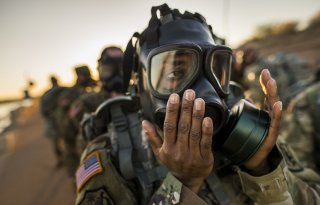 Could one of the U.S. Defense Department’s many underground complexes work as a secure headquarters from which to direct military operations during a pandemic?
Could one of the U.S. Defense Department’s many underground complexes work as a secure headquarters from which to direct military operations during a pandemic?
Probably not, according to new reporting from Sean Naylor of Yahoo! News.
In 2006, during a global outbreak of the H5N1 “bird flu” virus, the Pentagon conducted an exercise testing its ability to command forces from Raven Rock, a bunker complex in Pennsylvania.
The Defense Department built Raven Rock during the early 1950s as one of several possible alternate command centers during a nuclear war. “Over the years, these facilities have been incorporated into the Pentagon’s plans for how to respond to other threats,” Naylor explained.
But by 2006, bunkers such as Raven Rock were of “diminishing value,” Paul McHale, at the time a senior Pentagon official, told Naylor.
The bunker just wouldn’t work as a pandemic H.Q. For the facility to function, it has to keep the disease outside its walls. But that’s almost impossible to do while also quickly bringing in the personnel the military would need to staff the bunker.
During the 2006 exercise, the Raven Rock team “screened a group of newly arrived personnel who were not routinely stationed at Raven Rock, to simulate what would have to be done amidst a crisis,” Naylor noted.
A series of bombings and shootings kill at least 98 people and injure 240 people across Iraq.
Gambling is legalized in Nevada.
“It was a dress rehearsal for what could be something larger,” retired U.S. Army colonel Daniel Roper, who commanded Raven Rock Mountain Complex at the time of the exercise, told Naylor. “The challenge is: How do you make it so the firemen aren’t burning your house down.”
During the 2006 exercise, no one playing the role of a sick individual made it into the bunker. But that result probably isn’t duplicatable during a real crisis, Roper said. “No test is a hundred percent foolproof.”
First of all, in the real world screening for disease takes time. A coronavirus test can require days under the best of circumstances. But the Raven Rock facility wasn’t built with a holding area for incoming personnel awaiting screening.
And who would conduct the tests? “All things being equal, you’d love to have an epidemiologist standing there,” Roper said. “But guess what, we’re probably going to run out of those guys pretty soon.”
And it’s not like the military can trust personnel to self-diagnose, even if they’re beginning to feel ill. “They want to do their jobs when the nation needs it the most,” Roper pointed out. “People are just going to say, ‘To Hell with it, I’ve never missed a day of work.’”
If the military tried to use a bunker as a pandemic H.Q., it probably would just end up packing a bunch of infected people into an enclosed space with uninfected people, creating even better conditions for the disease’s spread.
“A hardened site would not, at least in my judgment, have been the proper choice” for a pandemic command center, McHale told Naylor. His recommendation, he said, would be to relocate senior leaders and their staffs to a major military installation as far from the pandemic as possible. No bunker needed.
David Axe serves as Defense Editor of the National Interest. He is the author of the graphic novels War Fix, War Is Boring and Machete Squad. This first appeared in May 2019 and is being reposted due to reader interest.
No comments:
Post a Comment